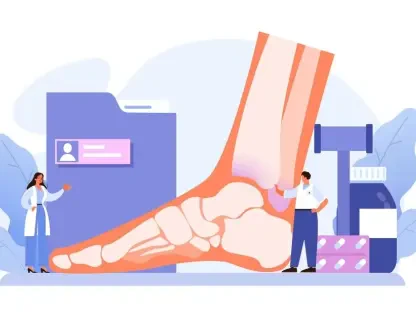Imagine being a retiree on a fixed income, carefully budgeting for healthcare, only to discover that the cost of your prescription drug plan under Medicare Part D is set to jump by as much as $50 per month. For millions of beneficiaries, this scenario is becoming a harsh reality, stirring concern and confusion. This roundup dives into the reasons behind these steep premium hikes for stand-alone Part D plans, gathering perspectives from industry leaders, policy analysts, and healthcare advocates. The purpose is to unpack the driving forces, compare differing viewpoints, and offer practical strategies to help enrollees manage the financial strain.
Understanding the Factors Behind Premium Increases
Escalating Prescription Drug Costs as a Primary Driver
One widely agreed-upon factor pushing Medicare Part D premiums upward is the relentless rise in prescription drug spending. Industry analysts point out that the cost of medications, particularly for chronic conditions like diabetes, often exceeds $1,000 monthly for uncovered beneficiaries. A recent report highlighted a growth of over 10% in drug spending, driven by both higher utilization and the introduction of expensive specialty drugs, compelling insurers to adjust premiums to offset their losses.
Differing opinions emerge on how to address this challenge. Some healthcare economists argue that insurers should negotiate harder with pharmaceutical companies to curb costs before passing them on to consumers. Others, including certain policy advocates, suggest that beneficiaries might need to bear a larger share of these expenses through tiered pricing models, though this raises concerns about access to essential treatments for lower-income enrollees.
Legislative Changes and Their Mixed Impact
The Inflation Reduction Act, with its $2,000 annual out-of-pocket cap on drug spending, has reshaped the cost landscape for Medicare Part D. Many policy experts praise this reform for protecting individuals with high drug expenses, noting that it prevents catastrophic outlays that could previously reach into the tens of thousands. However, this relief shifts a significant burden to insurers, who are now raising premiums across the board to compensate.
Contrasting views surface on the fairness of this cost distribution. Some industry observers contend that spreading the expense among all enrollees undermines affordability for those with minimal drug needs. On the other hand, consumer advocacy groups argue that this collective approach ensures a safety net for everyone, emphasizing that any beneficiary could face high costs due to an unexpected health crisis.
Federal Funding Reductions Stirring Debate
Another critical factor is the reduction in federal support for a stabilization program meant to temper premium growth. Initially successful in lowering average premiums by 9%, the program now faces a 40% funding cut, dropping per-enrollee subsidies and allowing maximum premium hikes to reach $50 monthly. Government officials defend this move as a way to reduce taxpayer burden, prioritizing fiscal restraint.
However, opinions split sharply on this policy shift. Healthcare policy analysts warn that slashing subsidies disproportionately harms stand-alone Part D enrollees, predicting significant premium spikes. In contrast, some fiscal conservatives maintain that insurers should adapt without heavy reliance on public funds, though they acknowledge the potential for reduced plan options as a consequence.
Stand-Alone Plans Versus Medicare Advantage Disparities
A notable disparity exists between stand-alone Part D plans and Medicare Advantage plans, with the latter often shielded from sharp premium increases due to higher government payments and rebates. Enrollment trends show a tilt toward Advantage plans, as beneficiaries seek more predictable costs, according to health insurance specialists. This funding gap highlights a structural imbalance in how drug coverage is supported.
Perspectives differ on the implications of this trend. Some analysts caution that Advantage plans, while cost-effective, may limit provider choices and impose barriers like prior authorization, which could deter certain enrollees. Others argue that the competitive edge of these plans drives innovation and efficiency, potentially benefiting consumers in the long run if accessibility issues are addressed.
Strategies to Mitigate the Impact of Rising Costs
Insights from various stakeholders converge on the importance of proactive engagement during open enrollment, which begins on October 15 each year. Beneficiaries are strongly encouraged to compare plans meticulously, as sticking with automatic renewals could lock them into higher premiums. Tools like Medicare’s online plan finder are frequently recommended by consumer advisors as a way to identify cost-effective options tailored to individual needs.
Differing tips also emerge on navigating plan selection. Some financial planners suggest prioritizing plans with lower premiums even if they offer less comprehensive coverage, especially for those with minimal drug use. Meanwhile, patient advocacy groups stress the value of assessing formularies—lists of covered drugs—to ensure essential medications remain affordable, balancing upfront costs with long-term health needs.
Reflecting on Shared Insights and Next Steps
Looking back, this roundup revealed a consensus among industry leaders, policy analysts, and advocates that Medicare Part D premium hikes stem from a complex interplay of soaring drug costs, legislative cost shifts, and reduced federal support. The discussions underscored a divide between stand-alone plans facing steep increases and Medicare Advantage plans offering relative stability, while opinions varied on the fairness and sustainability of current policies. Moving forward, beneficiaries should take actionable steps by leveraging open enrollment to explore alternatives and using available resources to make informed choices. Additionally, staying engaged with ongoing policy debates—such as potential expansions in drug coverage or adjustments to funding mechanisms—could empower enrollees to advocate for more balanced solutions in the evolving healthcare landscape.









